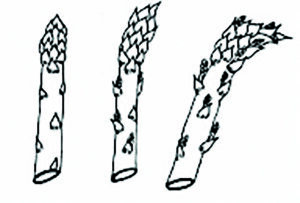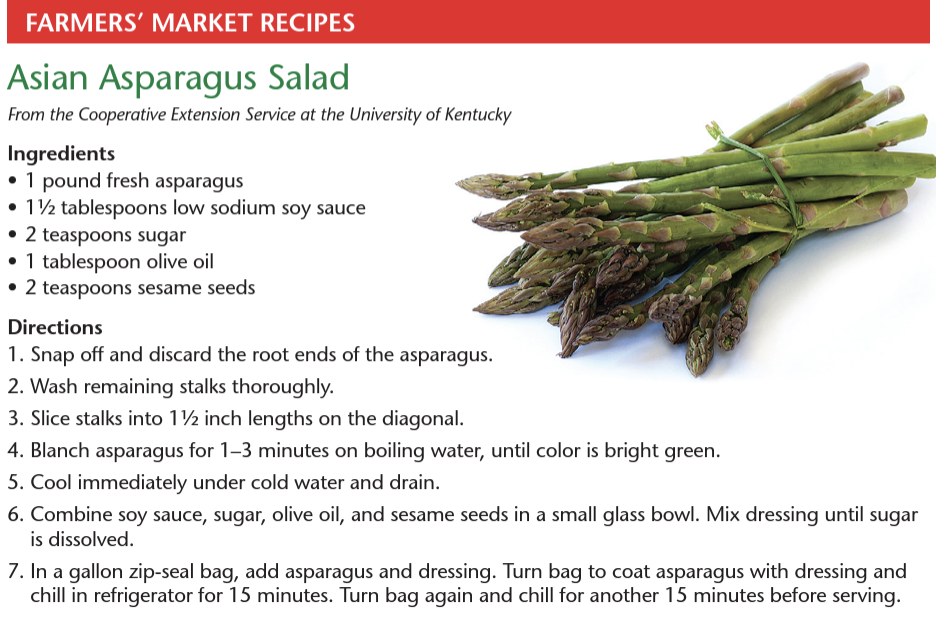Asparagus Nutrition Facts
go.ncsu.edu/readext?1066672
en Español / em Português
El inglés es el idioma de control de esta página. En la medida en que haya algún conflicto entre la traducción al inglés y la traducción, el inglés prevalece.
Al hacer clic en el enlace de traducción se activa un servicio de traducción gratuito para convertir la página al español. Al igual que con cualquier traducción por Internet, la conversión no es sensible al contexto y puede que no traduzca el texto en su significado original. NC State Extension no garantiza la exactitud del texto traducido. Por favor, tenga en cuenta que algunas aplicaciones y/o servicios pueden no funcionar como se espera cuando se traducen.
Português
Inglês é o idioma de controle desta página. Na medida que haja algum conflito entre o texto original em Inglês e a tradução, o Inglês prevalece.
Ao clicar no link de tradução, um serviço gratuito de tradução será ativado para converter a página para o Português. Como em qualquer tradução pela internet, a conversão não é sensivel ao contexto e pode não ocorrer a tradução para o significado orginal. O serviço de Extensão da Carolina do Norte (NC State Extension) não garante a exatidão do texto traduzido. Por favor, observe que algumas funções ou serviços podem não funcionar como esperado após a tradução.
English
English is the controlling language of this page. To the extent there is any conflict between the English text and the translation, English controls.
Clicking on the translation link activates a free translation service to convert the page to Spanish. As with any Internet translation, the conversion is not context-sensitive and may not translate the text to its original meaning. NC State Extension does not guarantee the accuracy of the translated text. Please note that some applications and/or services may not function as expected when translated.
Collapse ▲April is peak asparagus season! It’s also one of the first spring vegetables to be ready for harvest. Asparagus is crisp and tender when cooked and is easy to grill at family cookouts thanks to its long and sturdy shape. Generally, thinner spears are more delicate and tender; thicker spears have stronger flavor and hearty texture. Thicker spears can be sliced on the diagonal into smaller pieces to cook more quickly. This popular vegetable comes in green, white, and purple colors. Green – the most common type. White – covered with soil as it grows to keep green pigments from developing. Considered a delicacy and may cost more than green. Purple – has more sugar and less fiber than green. The skin is burgundy or purple but the flesh is pale green to creamy white. Cooking may cause more green color to show. Less commonly available and may cost more than green. Asparagus benefits include its low caloric value and its high vitamin, mineral, and antioxidant content. Asparagus is a great source of fiber, vitamin K, and folate! Fiber is beneficial to gut health and may help lower blood cholesterol. Vitamin K assists in blood clotting, which helps us heal from cuts and wounds. Folate helps in making new cells in our bodies, which is why it’s so important during pregnancy. Just half a cup of cooked asparagus contains
- Calories: 20
- Protein: 2.2 g
- Fat: 0.2 g
- Fiber: 1.8 g
- Vitamin C: 12% of the RDI
- Vitamin A: 18% of the RDI
- Vitamin K: 57% of the RDI
- Folate: 34% of the RDI
- Potassium: 6% of the RDI
- Phosphorous: 5 % of the RDI
- Vitamin E: 7% of the RDI

Photo credit: OSU Extension
For fresh asparagus, choose bunches with stalks that are bright green or purple-tinged with firm stems. Avoid limp or wilted stalks. Thicker stalks have a stronger asparagus flavor while thin stems are more tender and sweeter. When looking at the spearhead, look for heads that are tight, like on the left side of the photo, and not “ferned out”. Refrigerate asparagus for up to four days by wrapping ends of stalks in wet paper towel and placing in plastic bag. Asparagus can be enjoyed raw or cooked, and it’s often a star ingredient in soups, stews, salads, and other dishes. Asparagus cooks quickly. Cook it until just barely tender. Thicker stalks take longer to cook. Overcooked or reheated cooked asparagus may become bitter and stringy or mushy.
❁ Boil or blanch in enough water to cover the stalks.
❁ Steam over boiling water.
❁ Sauté or stir-fry in a small amount of oil or fat.
❁ Roast or grill until lightly browned.
Farmers’ Market Recipes
Asian Asparagus Salad
From the Cooperative Extension Service at the University of Kentucky.

Ingredients
• 1 pound fresh asparagus
• 1½ tablespoons low sodium soy sauce
• 2 teaspoons sugar
• 1 tablespoon olive oil
• 2 teaspoons sesame seeds
Directions
1. Snap off and discard the root ends of the asparagus.
2. Wash remaining stalks thoroughly.
3. Slice stalks into 1½ inch lengths on the diagonal.
4. Blanch asparagus for 1-3 minutes on boiling water, until color is bright green.
5. Cool immediately under cold water and drain.
6. Combine soy sauce, sugar, olive oil, and sesame seeds in a small glass bowl. Mix dressing until sugar is dissolved.
7. In a gallon zip-seal bag, add asparagus and dressing. Turn bag to coat asparagus with dressing and chill in refrigerator for 15 minutes. Turn bag again and chill for another 15 minutes before serving.
Asian Asparagus Salad Recipe card
For more information or Family & Consumer Science questions, feel free to call your local Cooperative Extension office at 919-496-3344.




